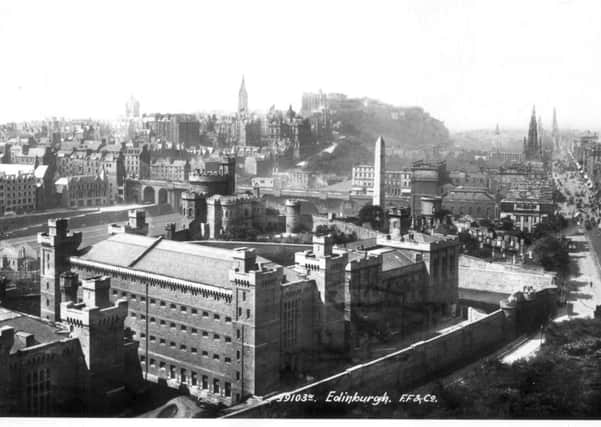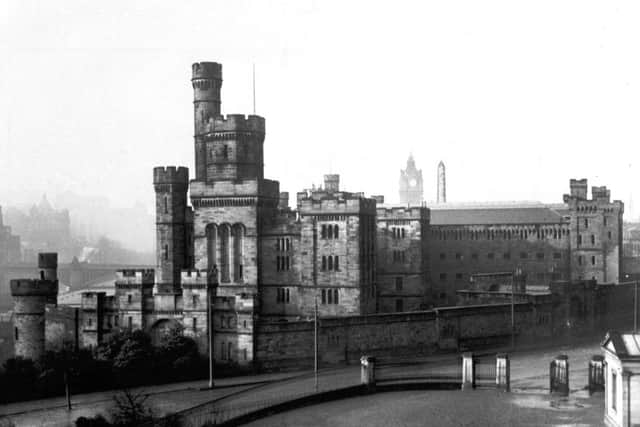Calton Jail's most daring escapes


Purpose-built in 1817 to replace the dilapidated Old Tolbooth located on the city’s High Street, Calton Jail had a fearsome reputation.
Too many times had prisoners managed to escape from the Old Tolbooth. For centuries the ancient city jail had been located slap bang in the middle of a busy thoroughfare; which made it easy for friends of the incarcerated to assist them from the outside.
Advertisement
Hide AdAdvertisement
Hide AdCalton prison on the other hand was a different matter. Constructed with high perimeter walls on the edge of a sheer cliff away from the hustle and bustle of the city centre, it was much more difficult to escape.


But not impossible.
Up and over
During early Spring 1823 three prisoners escaped in “a most remarkable manner”.
Their names were Matthew Adie, Lawrence Hughes and James Curly. The latter individual was in jail for forging bank notes.


As newspapers reported at the time, the trio had been employed by the turnkeys to carry coal from the round house to the lodge at the entrance to the jail when they made their way up to the top of one of the turrets above the gate and escaped. The incident took place in broad daylight.
Two of the men, Adie and Hughes, were later apprehended in Newcastle and sentenced to transportation to the colonies for life. Incredibly, it was not third man James Curly’s first time breaking out from prison; he had previously escaped incarceration in Stirling. As far as can be deduced, Curly’s name doesn’t appear again, so we must assume that he was successful in evading capture this time around.
A brush with the law
The following year, one prisoner named Thomas Hamilton spotted an opportunity when his cell was being repainted. Hamilton, who had been locked up for pickpocketing posed as one of the decorators by covering himself in paint. The plucky felon, paint tin in hand, was able to walk straight out of the jail unchallenged.
A most ‘hardened and mischievous set’
Also in 1824, a group of 22 felons masterminded an elaborate plan to escape via a large hole in the wall leading to the common sewer. The group’s plot, which included the murder of a turnkey with a sharpened table knife, was foiled, however, and all 22 men, considered the “most hardened and mischievous set that have ever been within the walls of the jail” were removed from Calton Hill and sent by ship to London.
Mass breakout
Advertisement
Hide AdAdvertisement
Hide Ad1825 witnessed one of the most audacious breakout attempts when no fewer than eight convicts broke from their confines and fled.
The prisoners managed to fight their way out with brute force. One guard was badly beaten up by a broomstick and others pushed to the ground as they rushed to the gates.
Having obtained a set of keys and broken out, the men made a run for it in the direction of Arthur’s Seat. It was later revealed that one of the turnkeys had colluded with the convicts in securing their escape.
Three of the prisoners, two of which had made it as far as Penicuik, were later caught and returned to their cells.
‘Turnkey, we’ve had a break-in’
A unique occurrence took place in October 1858 when a group of men, thought to be former inmates, broke IN to Calton prison.
The men scaled the walls and picked the locks of the entrance gate with the purpose of committing theft.
Clerks arrived the next morning to find that the jail had been ransacked of valuables and a sum of 20 shillings in notes and gold had been plundered.
Cliff-hanger
Advertisement
Hide AdAdvertisement
Hide AdIn July 1883 a convict named Creamor made a desperate attempt to break out of the jail. Part of the prison was being rebuilt and Creamor, walking by the works, made a dash up one of the ladders leaning against the boundary wall.
Creamor managed to climb to the top of the wall but fell on to the cliffs below, severely injuring himself. He was swiftly taken back inside the prison where his wounds were attended to.
French leave
In 1894 a man, who had been serving a sentence for the serious assault of his brother, succeeded in escaping.
After being diagnosed with inflammation of the lungs and pleurisy, the prisoner, named McGoochan, was transferred from the Calton Hospital to the Royal Infirmary where he spent five or six weeks before being moved to the Convalescent Home at Corstorphine to complete his recovery. Patients at the home, including prisoners, were permitted to take ‘French leave’ and explore the grounds freely. McGoochan made his escape through a series of open gates having been wandering the grounds. He only had 14 more days of his sentence to serve and faced a severe punishment if found by the authorities. McGoochan was never re-captured.
Ferry to Burntisland
On 16 May 1900 Leith labourer William Wilson caused a great deal of excitement among the prison fraternity when he made one of the most ‘daring’ dashes for liberty ever recorded at Calton Jail.
While the prisoners were on their exercise hour, Wilson somehow managed to scale the 18 feet high walls using only a plank of wood.
Once over the other side of the wall, Wilson made a bee-line north to a friend’s residence in seedy Lower Greenside. Prison guards didn’t realise he was gone until the exercise hour had come to an end.
Advertisement
Hide AdAdvertisement
Hide AdWilliam Wilson’s freedom lasted just a few hours. He was eventually caught attempting to board the Granton-Burntisland ferry, and swiftly taken back to jail in a cab.
Jail closure
Calton Jail closed in 1925, with demolition following five years later.
The Government building St Andrew’s House was built on its site.
Only the former Governor’s House and part of the perimeter walls of the old jail remain.
Bodies of several convicts who had been executed at the jail lie under the car park of St Andrew’s House to this day.